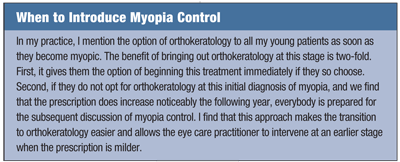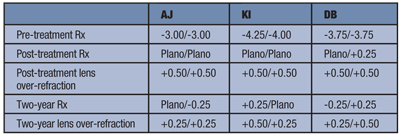 The last 10 years have brought us a number of studies that looked at the effects of orthokeratology on the progression of myopia. For the most part, these studies found ortho-k to be a safe and effective means for correcting vision and slowing myopia progression.1-3 Participants in the studies reported no serious adverse events, good daytime vision and reduction in the progression of myopia by 40% to 50% vs. the control groups.
The last 10 years have brought us a number of studies that looked at the effects of orthokeratology on the progression of myopia. For the most part, these studies found ortho-k to be a safe and effective means for correcting vision and slowing myopia progression.1-3 Participants in the studies reported no serious adverse events, good daytime vision and reduction in the progression of myopia by 40% to 50% vs. the control groups.
The Fitting
I had the opportunity to fit my own son—AJ, a then nine-year-old -3.00D myope—and two of his friends in orthokeratology lenses at approximately the same time nearly three years ago. The two other boys had the following specs: KI was 10-year-old and had progressed to a -4.25 prescription in each eye, while DB was an 8-year-old who refracted at -3.75 OU. All three children had seen their prescription jump by at least one diopter at each of their previous two eye exams. They were all actively involved in sports and dealing with the issues of eyeglass wear, or not wear, in many cases.
 Our family has low to moderate myopia, while the two other children had parents with highly myopic corrections.
Our family has low to moderate myopia, while the two other children had parents with highly myopic corrections.
In all three instances, the fitting of lenses was straightforward and typical. Using CRT (Paragon) lenses, manifest refraction and corneal topography, I followed the fitting guidelines and made recommended modifications to achieve optimal results. All three children achieved 20/20 to 20/25 vision in each eye, and all three had 20/20 vision OU.
The Follow-Up
Since the initial fitting, I have seen all three boys for two annual exams (see table). All three have continued in the same lens parameters for the past three years. An excellent way to monitor for change in Rx is by over-refracting through the orthokeratology lens. This gives you a repeatable method to routinely check the prescription for progression without impacting the quality of treatment.
In over two years, none of children progressed by more than 0.25D, as compared to the change of 1.00D or greater in the three years prior. Not only are the children happy with their vision and freedom from corrective lenses, the parents (myself included) are thrilled to know that their child’s visual decline has slowed significantly.
Thinking Ahead
 Early studies show that orthokeratology can account for a roughly 50% reduction in the progression of myopia.2,4 Newer studies seem to confirm these findings.1 Do we now have enough compelling evidence that this slowing of myopia is real and permanent?
Early studies show that orthokeratology can account for a roughly 50% reduction in the progression of myopia.2,4 Newer studies seem to confirm these findings.1 Do we now have enough compelling evidence that this slowing of myopia is real and permanent?
We are seeing that the topic of myopia control—and the treatment of orthokeratology—is increasingly mentioned within the field of eye care. The evidence to support the positive impact of orthokeratology is strong and growing. But all literature aside, there is nothing like seeing first-hand the impact that you can make on your young patients.
1. Cho P, Cheung SW. Retardation of myopia in orthokeratology (ROMIO) study: as 2-year randomized clinical trial. Invest Ophthalmol Vis Sci. 2012 Oct 11;53(11): 7077-85.
2. Walline JJ, Rah MJH, Jones LA. The children’s overnight orthokeratology investigation (COOKI) pilot study. Optom Vis Sci. 2004 Jun;81(6):407-13.
3. Lee TT, Cho P. Discontinuation of orthokeratology and myopia progression. Optom Vis Sci. 2010 Dec;87(12):1053-6
4. Cho P, Cheung SW, Edwards M. The longitudnal orthokeratology research in children (LORIC) in Hong Kong: a pilot study on refractive changes and myopic control. Curr Eye Res. 2005 Jan;30(1):71-80.


